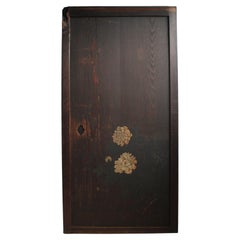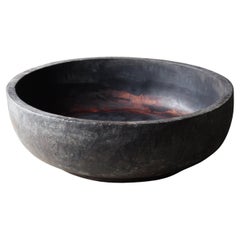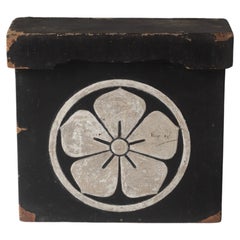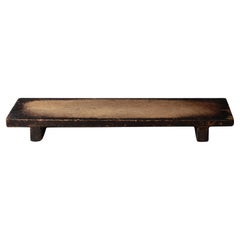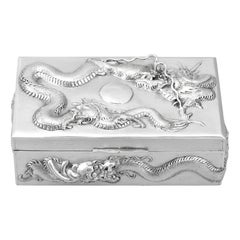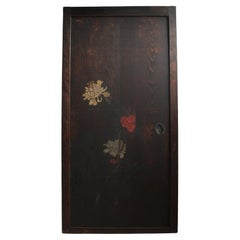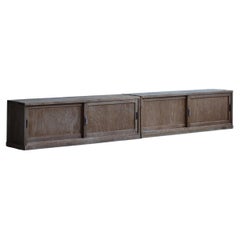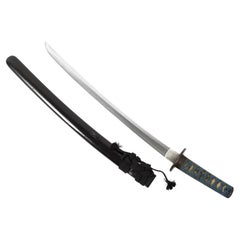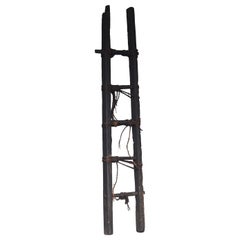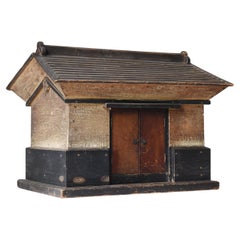Cedar Antiquities
to
2
2
10
1
1
8
1
1
1
1
1,076
706
548
497
281
11
11
10
1
11
11
11
Material: Cedar
D2 Japanese Antiques Board painting, sliding door, fittings, Peony & Bamboo
Located in Niiza, JP
Size: Depth *3cm Width *87cm Height *173cm 8kg
Estimated packing size: (Sandwich with 4-5mm plywood)
12 × 100 × 185cm 20kg
This is an old fittings of ita-e (wooden board painting)...
Category
19th Century Japanese Antique Cedar Antiquities
Materials
Cedar
Japanese Antique Huge Wooden Bowl 1906s / Primitive Object Wabisabi Mingei
Located in Chōsei District Nagara, JP
This is a huge old Japanese lacquer wood bowl.
It was manufactured in 1906 (Meiji period), and its age can be read from the writing on the bottom. The material used is cedar wood, ma...
Category
Early 1900s Japanese Meiji Antique Cedar Antiquities
Materials
Cedar, Lacquer
Japanese Antique Black Lantern Box /1896s Objet d'art Wabi-sabi
Located in Iwate-gun Shizukuishi-cho, Iwate Prefecture
This is a lantern box from the old days of Japan.
The box is pasted with Japanese paper and painted with black lacquer.
There is a description of "Meiji 29" on the back.
The lantern box is a box that stores folded lanterns...
Category
1890s Japanese Meiji Antique Cedar Antiquities
Materials
Wood, Cedar, Paper
$320 Sale Price
46% Off
Japanese Antique Exhibition Table / Wall Decoration / 1868-1912s / Wabi-sabi
Located in Iwate-gun Shizukuishi-cho, Iwate Prefecture
This is an old Japanese wooden work board.
The wood is cedar, and due to long-term use, the black color around the edges remains, and the color has peeled off only in the middle. Th...
Category
Late 19th Century Japanese Meiji Antique Cedar Antiquities
Materials
Wood, Cedar
1920s Chinese Export Silver Box
Located in Jesmond, Newcastle Upon Tyne
An exceptional, fine and impressive antique Chinese Export silver box; an addition to our collection of boxes and cases.
This exceptional an...
Category
1890s Chinese Chinese Export Antique Cedar Antiquities
Materials
Silver
D1 Japanese Antiques Board painting, sliding door, fittings, Peony & Bamboo
Located in Niiza, JP
Size: Depth *3cm Width *87cm Height *173cm 8kg
Estimated packing size: (Sandwich with 4-5mm plywood)
12 × 100 × 185cm 20kg
This is an old fittings of ita-e (wooden board painting)...
Category
19th Century Japanese Antique Cedar Antiquities
Materials
Cedar
wabi sabi reclaimed boat wood wall decor, bamboos engraved. circa 1870s-1920s
Located in 常陸大宮市, JP
Wooden wall decor made of a piece of reclaimed wood from antique wood river boat. Words & bamboos engraved, together with the signature. Strings for hanging attached.
manufactured ci...
Category
Late 19th Century Japanese Meiji Antique Cedar Antiquities
Materials
Wood, Cedar
$640 Sale Price
20% Off
Japanese Antique Black Bellows / An objet d'art / 1868-1912s / Wabi-Sabi Mingei
Located in Iwate-gun Shizukuishi-cho, Iwate Prefecture
This is an old Japanese Bellows.
In Japan, it is called "Fuigo".
It was used in a private house in the Tohoku region of Japan.
To make swords, etc., it is necessary to melt jade st...
Category
Late 19th Century Japanese Meiji Antique Cedar Antiquities
Materials
Wood, Cedar
Japanese Wall Art / Japanese objet / wabi-sabi art / primitive wall art
Located in Sammu-shi, Chiba
This is a wall art made using some of the material from an old Japanese door.
This is a wooden door reinforced with galvanized iron sheets.
It's a convenient size that doesn't take...
Category
2010s Japanese Primitive Cedar Antiquities
Materials
Tin
Japanese Antique Exhibition Stand / Sword Case / 1800-1868s / Wabi-sabi
Located in Iwate-gun Shizukuishi-cho, Iwate Prefecture
This is an old drawer for storing Japanese swords originally called "Katanatansu".
It is thought to be from around the Edo period.
Cedar is used for the material, and a large numbe...
Category
Mid-19th Century Japanese Edo Antique Cedar Antiquities
Materials
Wood, Paper, Cedar
Japanese Kamakura/Muromachi Period Cedarwood Buddhist Priest, 12th-15th Century
Located in Amsterdam, NL
Seated Buddhist priest
Japan, Kamakura period (1185-1333) or Muromachi period (1333-1573).
Different carved hollow blocks of cedar wood joined togeth...
Category
15th Century and Earlier Japanese Antique Cedar Antiquities
Materials
Cedar
Related Items
Japanese Antique Cabinets , Low board Storage , Wabi Sabi, Japandi
Located in Katori-Shi, 12
A pair of antique Japanese lowboards.
Made of high-quality oak wood, it has a deep texture that comes from years of use.
The simple yet powerful wood grain stands out, creating a s...
Category
Early 20th Century Japanese Taisho Cedar Antiquities
Materials
Wood
$1,600
H 13.19 in W 41.34 in D 9.65 in
Antique Japanese Koto Wakizashi Sword
Located in Dallas, TX
Japanese Koto Wakizashi Sword
Japan
Ca. 1400-1600s
Length: 24.25” Blade
Total Length: 27.25
Nagasa: 18.5”
Koto wakizashi, with wild midare (Soshu?) hamon, including wild boshi. Hada indeterminate, with Shakudo & gold dragon menuki, beehive design fuchi kashira...
Category
16th Century Japanese Japonisme Antique Cedar Antiquities
Materials
Steel
Unique 19th Century Export Chinese Gilt Chinoiserie Lacquer Box
Located in Brea, CA
Unique 19th century export Chinese gilt chinoiserie lacquer box with hand painted scenes gilt export black lacquer, this box has a unique shape, it is f...
Category
Mid-19th Century Chinese Qing Antique Cedar Antiquities
Materials
Lacquer
Japanese Antique sofa side table, Wabi Sabi, Japandi
Located in Katori-Shi, 12
A simple yet powerful and elegant round table.
The soft wood grain of cherry wood and the beautiful aged texture of the base material combine to create a quiet presence.
The origina...
Category
Early 20th Century Japanese Taisho Cedar Antiquities
Materials
Wood
Japanese Antique Hinoki wood sliding door cabinet , Wabi Sabi, Japandi
Located in Katori-Shi, 12
A sliding door cabinet with a neat appearance, assembled from cypress wood.
The old glass and bare wood give it a beautiful tranquility.
The top is luxuriously made of a single pie...
Category
Early 20th Century Japanese Taisho Cedar Antiquities
Materials
Wood
$3,700
H 35.04 in W 65.95 in D 15.63 in
Japanese Antique Open shelf, Wabi Sabi, Japandi
Located in Katori-Shi, 12
This antique is just the right size for a storage shelf.
This is a rare shelf with flap doors that has a Japanese essence.
A flap door is a door that can be opened and stored insid...
Category
Early 20th Century Japanese Taisho Cedar Antiquities
Materials
Wood
Japanese Antique Cabinets, Wabi Sabi, Japandi
Located in Katori-Shi, 12
This is an antique Japanese-style cabinet made in the Meiji period.
The texture of the black lacquer, smoked with soot from the hearth, has a unique depth and charm that is unlike a...
Category
Early 20th Century Japanese Meiji Cedar Antiquities
Materials
Wood
Wooden Low Table, Japanese Antique, Wabi-Sabi, Mingei
Located in Katori-Shi, 12
This is an antique wooden low table from the Taisho period.
It was used as a workbench by a craftsman at the time, and although it is unclear which craftsman used it, there are smal...
Category
Early 20th Century Taisho Cedar Antiquities
Materials
Wood
Japanese Antique Wooden Board Art Single Board Grain of wood 1940s Wabi-Sabi
Located in Chiba, Chiba
This is an old Japanese wooden board.
It is a single board with beautiful wood grain.
I think this was probably used for the top of the work table.
It was already in this state when...
Category
Mid-20th Century Japanese Showa Cedar Antiquities
Materials
Wood
$350 Sale Price
50% Off
H 2.37 in W 40.56 in D 35.36 in
Japanese Antique Cabinets, Wabi Sabi, Japandi
Located in Katori-Shi, 12
This is a Japanese antique cabinet made in the Meiji period.
This is a masterpiece that highlights traditional techniques and craftsmanship, ...
Category
Early 20th Century Japanese Meiji Cedar Antiquities
Materials
Wood
Japanese Antique Chests of Drawers , Wabi-Sabi
Located in Katori-Shi, 12
This antique Japanese chest of drawers dates back to the Meiji period.
This chest is made from sturdy cedar wood with a lacquer finish, and the iron handles add industrial elegance....
Category
Early 20th Century Japanese Meiji Cedar Antiquities
Materials
Wood
Japanese Antique Cabinets , Low board Storage , Wabi Sabi, Japandi
Located in Katori-Shi, 12
This is an antique lowboard made in Japan. In Japan, it was used as a flooring.
A flooring is a platform that can be moved, like the floorboards of a tokonoma, which is indispensabl...
Category
Early 20th Century Japanese Taisho Cedar Antiquities
Materials
Wood
$3,900
H 9.93 in W 66.34 in D 8.47 in
Previously Available Items
Japanese Antique Wabi-Sabi Black Ladder 1800s-1860s / Primitive Object
Located in Chōsei District Nagara, JP
This is a very old black ladder made in Japan.
The simple construction and condition suggest that it was used in the late Edo period (1800s-1860s).
It is made of cedar wood with stra...
Category
Late 19th Century Japanese Primitive Antique Cedar Antiquities
Materials
Straw, Cedar
H 83.67 in W 18.12 in D 4.34 in
Japanese Antique Architectural Model " KURA 蔵 " 1860s-1920s / Figurine Wabi Sabi
Located in Sammu-shi, Chiba
This account is operated by four companies.
We are proud that this high quality assortment is the top in Japan in the Japanese antique market.
As for me, I specialize in Japanese ant...
Category
Early 20th Century Japanese Meiji Cedar Antiquities
Materials
Plaster, Wood, Cedar
H 18.12 in W 23.82 in D 17.33 in
Japanese wooden grain thrasher - antique farm tool, wabi sabi art piece, mingei
Located in 常陸大宮市, JP
This is a part of Japanese antique wooden grain thrasher for rice & wheat, called "Senbakoki" - thrashing the bundle of grain with this comb-like part.
It's a unique, wabi sabi art ...
Category
Early 20th Century Japanese Folk Art Cedar Antiquities
Materials
Wood, Cedar
H 8.47 in W 46.07 in D 4.14 in
Japanese Antique Huge Door " Wall Decoration " 1860s-1900s / Wabi Sabi
Located in Sammu-shi, Chiba
What used to be a large sliding door used in old Japanese warehouses.
It was made in the Meiji era. (1860s-1900s).
The frame is made of walnut, and the straw-wrapped member in the ce...
Category
Early 20th Century Japanese Meiji Cedar Antiquities
Materials
Iron
H 72.45 in W 45.28 in D 3.35 in
Japanese Antique Wabi-Sabi Cedar Wood Partition 1860s-1920s
Located in Sammu-shi, Chiba
This is a very old wooden partition made in Japan.
It is an item from the Meiji period (1860s-1920s).
It is made of cedar wood.
The overwhelming beauty of the cedar wood grain is at...
Category
Early 20th Century Japanese Meiji Cedar Antiquities
Materials
Cedar
Japanese Antique Low Partition "結界" 1860s-1900s / Wabi Sabi
Located in Sammu-shi, Chiba
This is an old low partition made in Japan.
The furniture is from the Meiji period (1860s-1900s).
It is made of cedar wood.
In Japanese Kanji, it is called “結界” .
It is a partition,...
Category
Early 20th Century Japanese Meiji Cedar Antiquities
Materials
Cedar
Japanese Antique BK Large Tansu 1860s-1900s / Sideboard Wabisabi
Located in Sammu-shi, Chiba
This is a very old Japanese large Tansu.
The furniture is from the Meiji period (1860s-1900s).
The material is cedar wood.
The design is ultimately simple and lean.
It is characteri...
Category
Early 20th Century Japanese Meiji Cedar Antiquities
Materials
Iron
Japanese Antique Architectural Model "KURA" 1860s-1920s / Wabi Sabi
Located in Sammu-shi, Chiba
This is a very old architectural model made in Japan.
The model is a “KURA (warehouse)” built in Japan between 1860 and 1920.
The foundation and framework are constructed of cedar w...
Category
Early 20th Century Japanese Meiji Cedar Antiquities
Materials
Plaster, Cedar
Japanese primitive stool / wabi-sabi stool / Flower stand
Located in Sammu-shi, Chiba
This is a stump of a large cedar tree whose corners have been worn down and rounded over time.
It is heavy and sturdy, and is about the same height as a low table chair, so it can b...
Category
Early 20th Century Japanese Primitive Cedar Antiquities
Materials
Cedar
Old Japanese simple wood grain wall hanging board / 1868-1920 / Wabi-sabi board
Located in Sammu-shi, Chiba
This is an old wooden work board made in Japan between the Meiji and Taisho periods.
It was used by farmers to cut mochi, udon, and soba noodles.
It was probably used on special occa...
Category
Late 19th Century Japanese Meiji Antique Cedar Antiquities
Materials
Cedar
H 32.21 in W 32.09 in D 2.17 in
Japanese Antique Rare Large Tansu 1860s-1900s / Sideboard Wabisabi
Located in Sammu-shi, Chiba
This is a very old Japanese large Tansu.
The furniture is from the Meiji period (1860s-1900s).
The material is cedar wood.
The design is ultimately simple and lean.
It is characteri...
Category
Early 20th Century Japanese Meiji Cedar Antiquities
Materials
Iron
Japanese antique wooden wabi-sabi board/wall hanging board/1868-1920
Located in Sammu-shi, Chiba
This is a work board used in an old Japanese house.
As you can see in the eighth detailed image, there are some parts that are lighter in color, but this is because it was used for ...
Category
Late 19th Century Japanese Meiji Antique Cedar Antiquities
Materials
Cedar
Recently Viewed
View AllMore Ways To Browse
Large Chinese Celadon Pots
Antique Slingshot
Bactrian Idol
Gandharan Schist
Geisha Pillow
Han Dynasty Bowl
Khmer Torso
Ancient Luristan Bronze
Chinese Terracotta Army Warriors
Cloisonne Pots Bonsai Trees
Greco Bactrian
Han Dynasty Amphora
Han Dynasty Court Lady
Palanquin Handles
Sancai Phoenix
Schist Gandharan Buddha
Bactrian Stone
Chinese Coconut Cup
